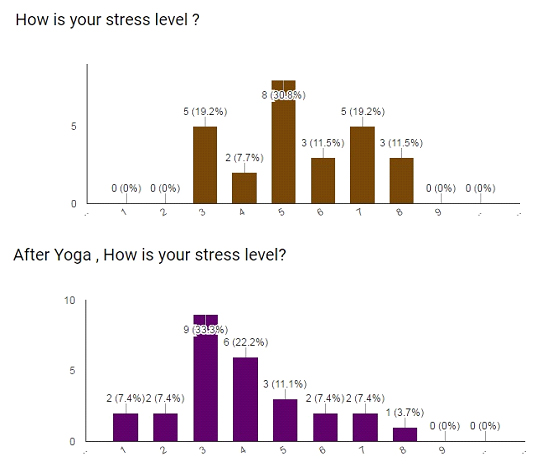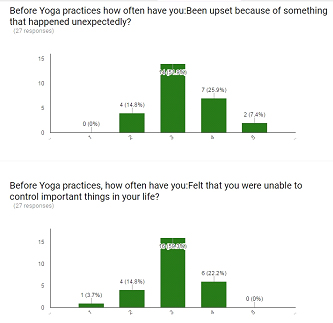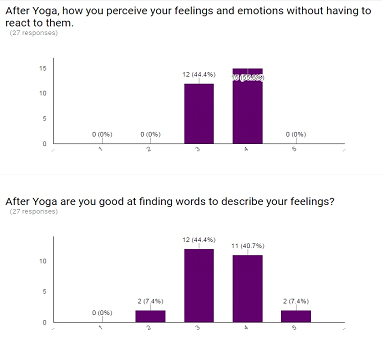Developing Mindfulness in Students with Yoga
by Kavi Vitya
Introduction
Yoga often brings to the mind the image of someone twisted in the shape of a pretzel. Yoga is usually associated with ‘asana’ (posture) and therefore in many of the fitness centres and gyms where yoga is being taught, emphasis to given to its physical aspect. However, deeper practice of yoga is beyond that. Patanjali’s definition of yoga is “Yoga Chitta Vritti Nirodhah”, which means “yoga is the removal of the fluctuations of the mind”. Chitta is mind, vritti is thought impulses and nirodhah is removal. Yoga practices can lead to mindfulness. Mindfulness means living in the moment. When you are mindful, you observe your thoughts and feelings from a distance, without judging them good or bad. Mindfulness is observing the thoughts without criticism and being compassionate to own self. Mindfulness brings long term happiness as it focuses less on unhappy thoughts and more practice on living in the present moment. It will positively affect the brain pattern to face daily life challenges without stress and anxiety. It is a simple mental training and it can be achieved with the awareness of breathing which is widely practiced in yoga.
Students encounter many issues pertaining to the mind and emotions. This often leads to them taking emotional and sometimes adverse decisions in life. Yoga classes are thus being conducted to observe the students behavioural, physical and mind changes. Through this study, I expect the students to have improved focus, reduced stress levels and enhanced decision-making ability in life by living in the present moment. Practicing Yoga would help them to be calmer and healthier not just physically but also mentally.
Yoga is well known to reduce stress and anxiety. This is due to the practice itself focusing on concentration and mindfulness which helps to keep the mind calm and centred. According to Patanjali Yoga Sutras chapter 1, the Samadhi Pada, which is the chapter on concentration shows there are five states of mind. The five states are Kshipta/disturbed, Mudha/dull, Vikshipta/distracted, Ekagra/mindfulness and Nirodhah/mastered. The ksihipta/disturbed mind is disturbed, restless, troubled, wandering. This is the least desirable of the states of mind, in which the mind is troubled. The mudha/dull mind is dull, heavy, and forgetful. It is a dull or sleepy state, somewhat like one experiences when depressed, though we are not here intending to mean only clinical depression. Then the Vikshipta/distracted mind is distracted, occasionally steady or focused. This mind can concentrate for short periods of time, and is then distracted into some attraction or aversion. Then, the mind is brought back, only to again be distracted. However, the Ekagra/mindfulness, focused, concentrated. When the mind has attained the ability to be mindfulness, the real practice of Yoga begins. It means that one can focus on tasks at hand in daily life, practicing karma yoga (the yoga of action) by being mindful of the mental process and consciously serving others. The person with a mindfulness mind just carries on with the matters at hand, undisturbed, unaffected, and uninvolved with those other stimuli. It is important to note that this is meant in a positive way, not the negative way of not attending to other people or other internal priorities. The mindfulness mind is fully present in the moment and able to attend to people, thoughts, and emotions at will. The final state of mind Nirodhah/mastered mind is highly mastered, controlled, regulated, and restrained. It is very difficult for one to capture the meaning of the Nirodhah state of mind by reading written descriptions. The real understanding of this state of mind comes only through practices of meditation and pranayama. Basically, the practice of mindfulness is based on the ancient teaching in the Patanjali sutras.
Methodology
The methodology used for this research was very simple. Research was carried out for 15 weeks where the students attended yoga classes for an hour per week. In the research I used use a qualitative method to analyse and derive data from a test beforehand to understand their level of mindfulness and an interview after the sessions completed. Every class had the following flow:
- 5 minutes of awareness practices
- 10 minutes of Pawanamuktasana (Joint exercises)
- 10 minutes Sun Salutation
- 20 minutes Yoga Asanas (poses)
- 15 Minutes of Pranayama (Breathing)
- Total: 1 hour practice
Result and Discussion
In total the study involved 27 students, 59.3% female and 40.7% male. The students that did not have yoga experience is 84.6 % of the total sample. Thus majority of the research participants did not have any yoga experiences.


1 =Least stress
10=Extremely stressed
The stress level of students when I ask them to scale their stress level before and after yoga you could observe the statistics that before yoga the total percentage level 5 and above is 73% and after yoga it has reduced to 29.6%. This shows Yoga could help them to manage their stresses of life better.
The Results of Mindfulness Test
I prepared 2 sets of mindfulness test. One set before yoga and another one after yoga samples of questions and results are as below.


Observe the differences in the both chart before yoga mostly moderate mindfulness and after yoga they have improved.
Conclusion
Yoga did improve the students’ state of mind to be more mindful, to be aware of their thoughts and improve their decision making ability. Fifteen weeks is not sufficient to achieve mindfulness completely and to train all students but I believe it’s a good start for the students to discover about mindfulness and yoga. One of the question in the questionnaire after 15 weeks was, “Share your opinion and overall experience throughout the 15 weeks of yoga practice.” Below are some of the feedback from students:
“Yoga has really helped me with my over thinking problem and made me an active person. I’ve learned to deal with problems in a steady state of mind.”
“I’m more conscious and aware of what I’m doing after the practice of yoga.”
“It was awesome as it helps to strengthen my mind when dealing with difficulties and control my emotions.”
“It was fun and beneficial. We learn new things every week and as we practice along the weeks, we get better and better at it. Yoga is definitely helpful in relaxing and dealing with stressful situations.”
“Yoga is a good exercise to practice anytime, anywhere, especially the breathing technique and the eye exercise. Yoga is a friendly exercise. It never forces you to do more than what you are able to do. There will always be an exception I the yoga pose. Yoga made me more aware of my own body, feelings, and thoughts. Throughout the 15 weeks of yoga practice, my yoga teacher showed me and others the good values of life. I feel motivated each time she gives us advices before the class dismissed.”
“It was truly an amazing experience. It was my first time trying out yoga and I’ve never thought it could be this fun and relaxing! Our yoga instructor was amazing. She helped us with the poses and praised us when we did a good job. I’ve never in my life thought I could actually do a handstand, but I now can (well, kind of)! The breathing techniques she taught and the advice she gave on being aware of our surroundings and ourselves were really helpful too. It was a wonderful 15 weeks and I will definitely be incorporating a bit of yoga into my everyday schedule.”
“I wish to start yoga classes again as yoga is a very helpful practice that improves my daily life. Difficult moments don’t seem so stressful anymore and happiness can be obtained easily!”
“I had a great time, bonded well with my friends in yoga and I feel fresher and I don’t get cramps anymore while playing football.”
“It’s a beneficial activity to fill in your time with and it’s interesting to learn something new each session. You gain experience and new skills.”
“Overall the yoga experience is very relaxing and helps me to enhance my mindfulness.”
It was an amazing experience to explore and do research about yoga and mindfulness. Yoga is a beautiful practice that can help not only the students but also the teacher to learn and progress. It was a great experience for me to guide and learn at the same time. Yoga brings mindfulness and Yoga is a universal healer. OM
References:
Swami Veda Bharathi (2001). Yoga Sutras of Patanjali: Samadhi pada. Delhi: Motilal Banarsidas
James Houghton Woods (2003). The Yoga Sutras of Patanjali. United States of America, USA: Dover publications Inc.
David Dapeng Chen, Linda Pauwels (2014). Perceived Benefits of Incorporating Yoga into Classroom Teaching: Assessment of the Effects of “Yoga Tools for Teachers” (4), 138-148
Mark William, Danny penman (2011). Mindfulness: An Eight Week Plan for Finding Peace in Frantic World. United States of America, USA: Rodale Inc.
This article was featured in YogaMail Jan-Mar 2017 issue.
